House Sparrows are cheery and gregarious visitors to gardens, never found far from humans. Their antics are fun to watch, although a small flock can be aggressive towards other birds and prevent them feeding, hence a ‘quarrel’ of sparrows!
Sadly they are becoming rarer with drastic population declines in recent years.
Scientific name: Passer domesticus
Is there anything you’d like to know about House Sparrows that isn’t covered here? Please ask us in the comments below.
On a little piece of wood,
Mr. and Mrs. Spikky Sparrow, by Edward Lear
Mr. Spikky Sparrow stood;
Mrs. Sparrow sate close by,
A-making of an insect pie,
For her little children five,
In the nest and all alive,
Singing with a cheerful smile
To amuse them all the while,
“Twikky wikky wikky wee,
Wikky bikky twikky tee,
Spikky bikky bee!”
Where do House Sparrows live?
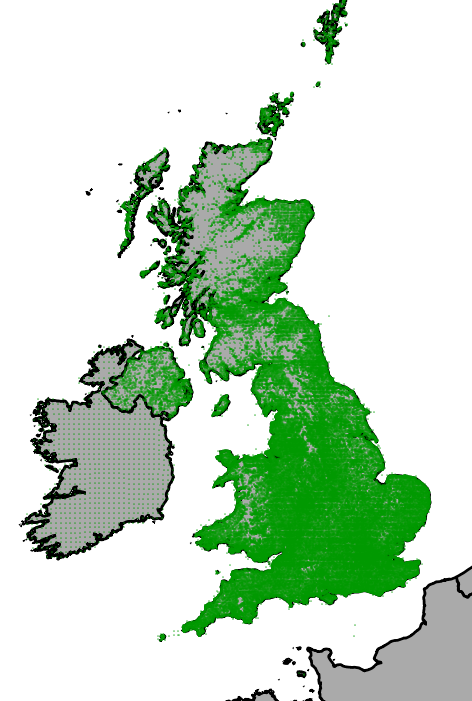

Usually never far from people, House Sparrows can be found in nearly all towns and cities as well as farmland across the UK, although are absent from more isolated upland areas. Apart from the far north of America and Asia, they have colonised or been reintroduced to most of the world, although they are also absent in east and southeast Asia where they are typically replaced by the Tree Sparrow.
They are present all year and rarely move far from their local area, with young birds also nesting not far from where they themselves were fledged.
What food do House Sparrows eat?
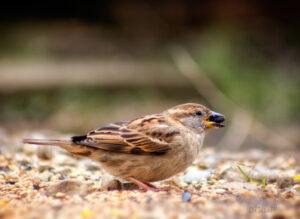
House Sparrows mainly eat seeds, cracked open by their strong beak. They are opportunists though, readily eating most scraps, and will happily visit bird tables and eat seeds and nuts from feeders.
When nesting they feed their chicks mostly insects, including caterpillars, aphids and beetles.
Where do House Sparrows nest?
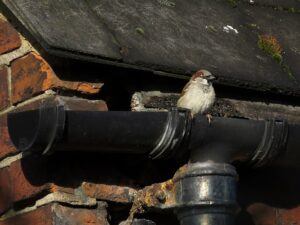
House Sparrows nest in small colonies, usually in holes in buildings such as under roof eaves, but sometimes they will build nests in thick vegetation or plants growing against walls. Nests are lined with dry grass and feathers, but also all sorts of other items including hair and paper!
House Sparrows pair for life, and usually use the same nest site year after year. They will readily use nest boxes, including ready-made sparrow terraced houses!
What do House Sparrows look like?
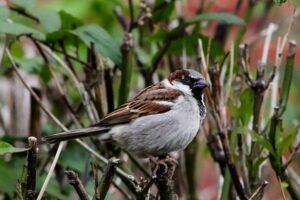
Male House Sparrows have a grey crown, warm brown back with black streaks, and a black bib and mask. It has been suggested that the larger the bib the more dominant the bird: pay attention to the birds in your garden and comment below if this seems to be the case!
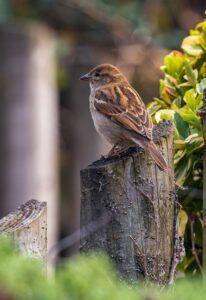
The female is paler brown overall, lacking the grey and black. She is light greyish below and has a creamy stripe behind the eye.
What do baby House Sparrows look like?
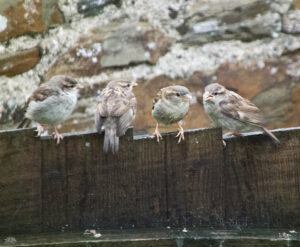
Young House Sparrows are very similar to adult females. Look for the ‘fleshy’ yellow gape, or base of the beak.
They will beg for food from their parents, often flicking their wings as they do, and being regular ground-feeders you might see this more often than with other species.
What do House Sparrows sound like?
Not a very melodious bird, but the various ‘chirps’ are a familiar and cheery sound. The full song is basically a repeated chatter of the different call notes.
You can listen to more from ‘A celebration of the sparrow‘.
How to attract House Sparrows?
If there are sparrows living in your area then providing a bird table with seeds and scraps, and hanging some feeders with nuts and seeds, may well attract them. Since they are usually in flocks they need some space, and open ground will help.
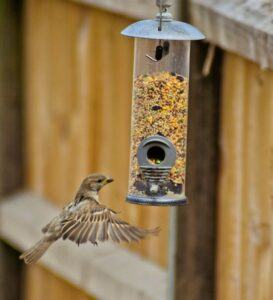
There should be cover nearby, ideally being hedgerows and large shrubs that may also offer nesting places. Otherwise, place several nest boxes together, or a purpose-made sparrow colony box.
A wild area of the garden that attracts insects, including some butterfly-friendly plants that will encourage them to lay eggs and hence produce caterpillars, will give sparrows (and other birds) an excellent food source for their chicks.
Gardens are a vital habitat for the declining House Sparrow, and the good news is that by caring for them we are making a positive difference to their overall populations!
More facts about House Sparrows
Where have all the sparrows gone?
There has been a drastic decline in the UK House Sparrow population over the past 30 years or so, in both urban and rural areas. In the countryside, intensive and more efficient farming, and reduced winter stubble, are thought to be major causes. In more urban areas the causes are less clear: a whole host of reasons have been suggested, including a lack of invertebrates to feed chicks, loss of nesting sites in modern buildings, predation by cats, increased pollution from cars, noise levels, higher instances of avian malaria exacerbated by climate change, and electromagnetic radiation from mobile phones.
The leading authority on sparrows, ornithologist J. Denis Summers-Smith, summarised the decline as long ago as 2003 in ‘The decline of the House Sparrow: a review‘ in British Birds magazine. More recently, a BTO survey illustrated the importance of suburban gardens for House Sparrows.
Although they have disappeared from many city centres, thankfully House Sparrows are still a common sight in most suburbs and villages, but more research and monitoring is needed to hopefully reverse the trend.
House Sparrow flocks
After breeding young House Sparrows will often form large flocks where there is a good supply of food, such as gardens and wasteland. In the autumn grain fields attract flocks of sparrows to feed together, before they disperse and return to breeding colonies.
Is the House Sparrow a pest?
Primarily because of introductions by man, the House Sparrow occurs throughout most of the world, and its opportunistic nature has meant it has flourished. However, it can be particularly aggressive over nest sites and food supplies, and represents a threat to many native species.
In North America, bluebirds and Purple Martins are two species impacted. In Australia the House Sparrow quickly became established in the east, and a major pest (although similar urban declines to elsewhere are now being noted). A Government campaign offered rewards for killing sparrows and destroying their nests and eggs, and this has prevented them extending their range to Western Australia.
The Sparrow’s tongue
A little-known fact is that sparrows have a ‘seed cup’ in the tongue, supported by an extra bone that other birds don’t have, to help them hold seeds to eat them.
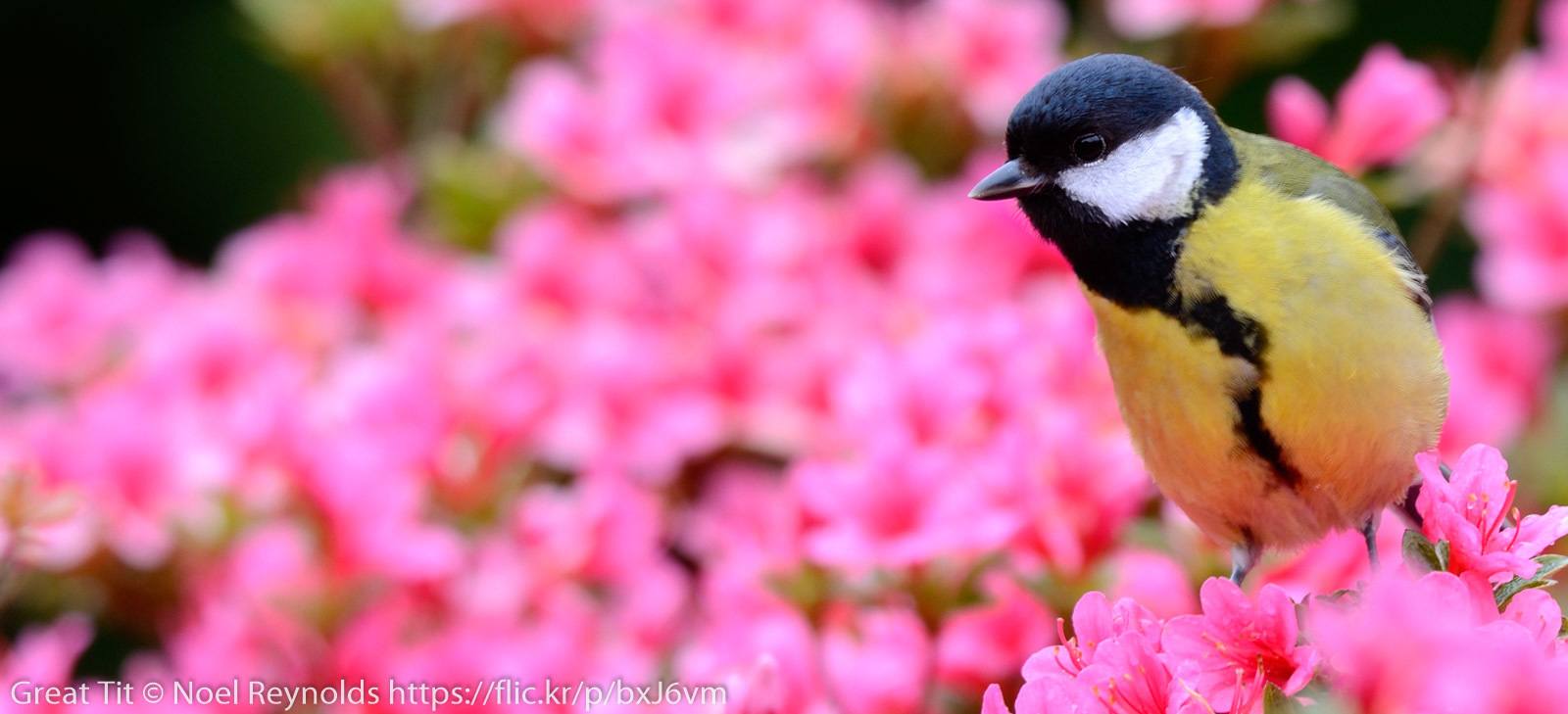
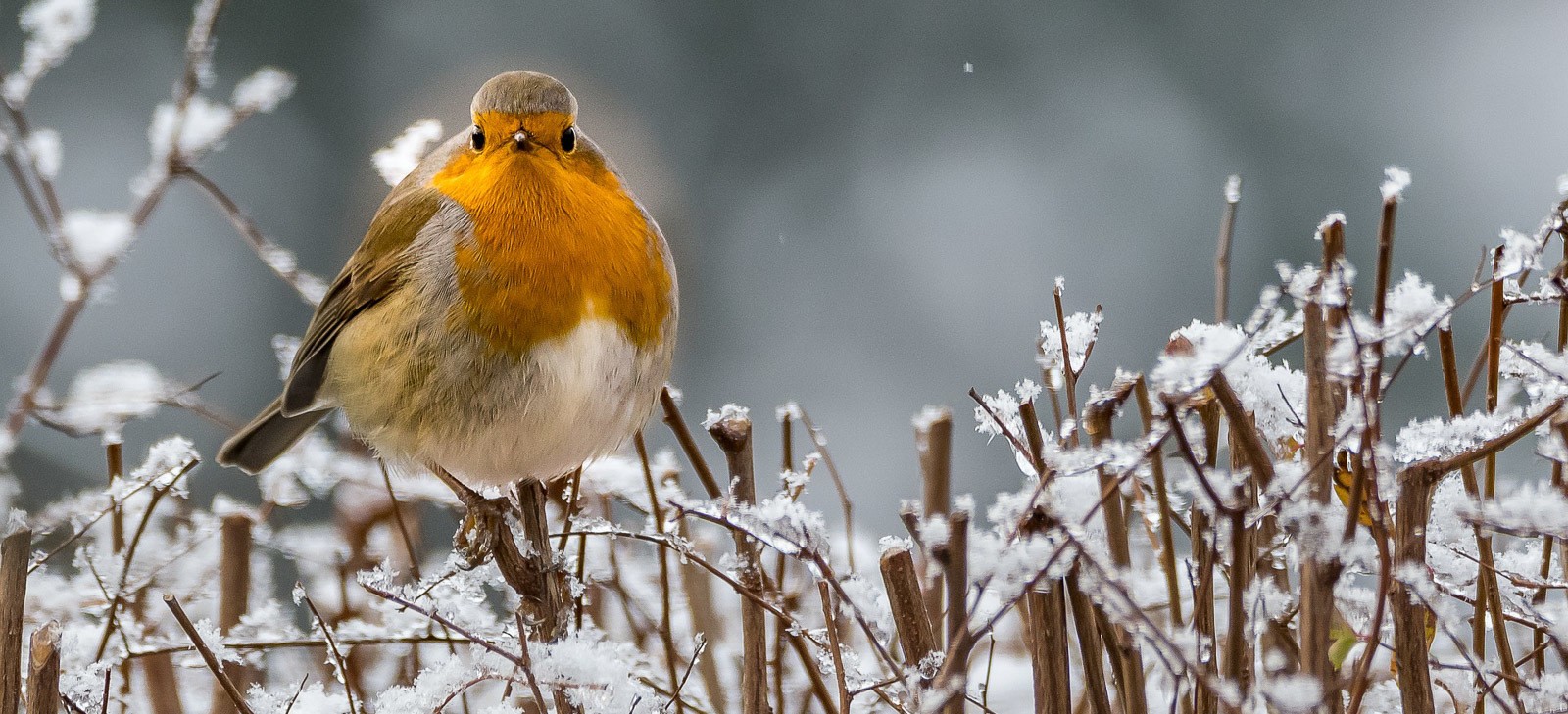
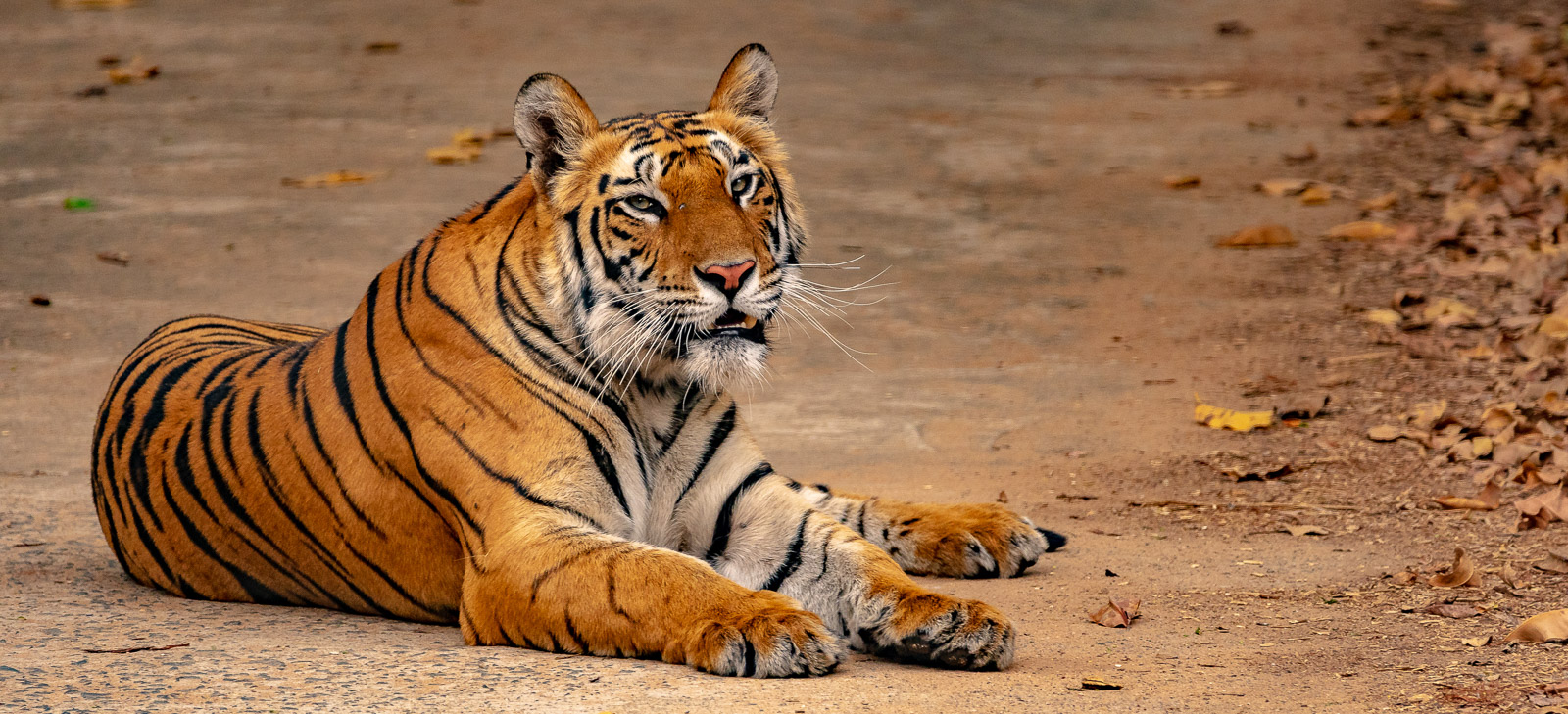
Great to see a bit of noise being made for these cheeky birds.
Can we do anything to save them . Can they be breeded and release in open . Can ……. I do something for them . I miss them
Hi Seema
House Sparrows are still a common bird and captive breeding would be very expensive and unnecessary. Whilst they are in decline long-term, recent trends have been more encouraging. Gardens are an important habitat for them, so providing shelter (e.g. planting hawthorn), food (e.g. seed mixes), and nest sites—you can even build your own “sparrow street”!—is important.
Watching our nearly fledged sparrows. Adults fly from nest box with white pellets. What would that be?
This is a faecal sac: the waste of young birds is excreted in a faecal sac, which the adults can easily remove from the nest so as not to bring attention to it.
I am lucky to have lots of sparrows living in a thick privet archway that is over my double gates. They know when it’s feeding time as when they hear my porch door opening, lots of heads suddenly appear all over the privet. I notice though that they don’t linger long at the bird table but land, peck at the food and fly back to the privet, making several quick journeys. Other species of birds tend to land and peck continuously. They always sound so happy. A true joy to have in my garden.
That sounds lovely! I’m lucky if I get a visit from a pair of sparrows every few weeks!
Since fledging from their nests in the eaves above, our new troop of about 25 sparrows chose the rosebush thicket below to make their `roost`. Unfortunately the juveniles foolishly took to flying down onto the lawn and perching in the flower border next door. Tragically, one ended up being snatched up by the dog next door, causing much chirping and distress to the others now perched on a wall overlooking the pitiful scene.
Over the boundary wall, we had gained lots of garden birds over the summer enjoying our breadcrumbs, wild-seeds and feeders hanging in our rose-rambler that straddled the end wall. But with the whole troop of sparrows deciding to make this their staple feeding station, the others obviously felt intimidated by their numbers flying in regularly to top up on their ever-hefty appetites, taking turns (half a dozen at a time) especially on the fatball0-cage which became their favourite feed. But I wonder why these sparrows show so little interest in seeds and so much on fatballs? As it is, we have stopped putting out fatballs in the hope that `the gang` may be prompted to explore the wider world, and, allowing the other birds some chance to return. Yes, of course we love the sparrows, but…lets be reasonable!